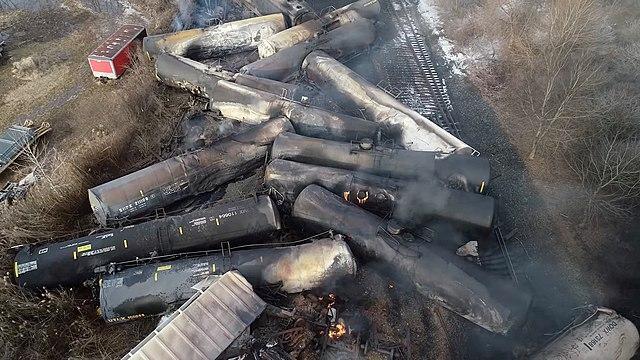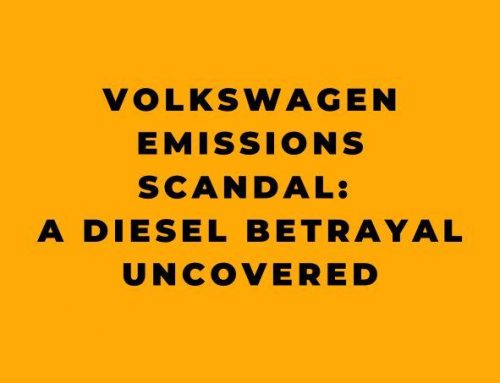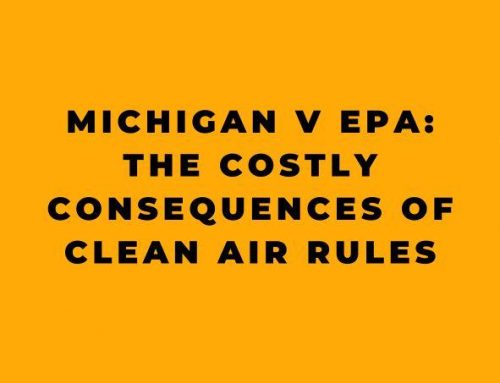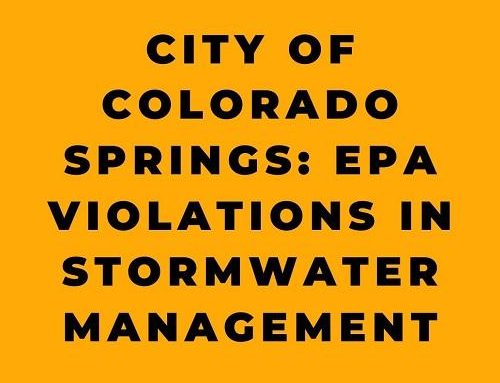What Happened?
On February 3, 2023, a Norfolk Southern freight train carrying hazardous materials derailed in East Palestine, Ohio, causing an evacuation of residents within a one-mile radius. Nearly 70 emergency agencies from Ohio, West Virginia, and Pennsylvania mobilized in response to the incident. The derailed train consisted of three locomotives, nine empty cars, and 141 loaded cars. The derailment was caused by a mechanical issue on one of the railcars’ trucks, which may have been connected to reports that an axle was observed throwing sparks about an hour before.
The U.S. Department of Transportation’s Pipeline and Hazardous Materials Safety Administration noted that the electronically controlled pneumatic brakes, which could have prevented the derailment, are significantly more expensive than the expected benefit, and the derailed train did not meet the qualifications of a “high-hazard flammable” train, meaning it was not affected by the 2014 legislation or its 2017 repeal. The material from the crash was observed in storm drains and detected in samples from Sulphur Run, Leslie Run, Bull Creek, North Fork Little Beaver Creek, Little Beaver Creek, and the Ohio River.
The derailment sent shockwaves through the town of East Palestine, and residents are still grappling with the aftermath. Many were forced to evacuate their homes and businesses, unsure of when they would be able to return. Others are concerned about the long-term health effects of the toxic chemicals that were released during the incident, and some are experiencing symptoms such as headaches and nausea.
The derailment has also sparked a larger conversation about railway safety in the United States, and many are calling for increased regulations and oversight of hazardous material transport by rail. Some have criticized the repeal of legislation that would have required electronic pneumatic brakes on trains, citing it as a contributing factor to the derailment. Others are concerned about the use of precision scheduled railroading, which prioritizes efficiency over safety and has led to longer and heavier trains, and a reduced number of workers per train.
What is Vinyl Chloride?
One of the hazardous materials carried by the derailed train was vinyl chloride, a colorless compound used to produce PVC plastic, wire coatings, and plastic kitchenware.
Vinyl chloride is a colorless, flammable gas that is used to manufacture polyvinyl chloride (PVC), a widely used plastic material. Vinyl chloride is also a known human carcinogen and can cause various health problems, including liver damage, respiratory issues, and nervous system damage. Inhaling high concentrations of vinyl chloride can cause dizziness, headaches, and even death. Vinyl chloride is also toxic to aquatic life, and exposure can lead to widespread environmental damage.
Why did Emergency Responders allow the chemical to burn?
Emergency crews conducted a controlled burn of the spill, which released hydrogen chloride and phosgene into the air.
Given the risks associated with vinyl chloride, some have questioned whether the decision to burn the chemical was the best course of action.
Vinyl chloride can be deadly if inhaled and can enter the air and drinking water supplies, and it is a common contaminant found near landfills. And because eposure to vinyl chloride can cause dizziness, headaches, liver damage, and even cancer, the burning of vinyl chloride during the controlled release led to concern among experts, with Chemistry Professor Neil Donahue expressing concern about the potential production of dioxins, while Public Health Dean Lynn Goldman worried about residual vinyl chloride. Murray McBride, a Professor of Soil Chemistry at Cornell University, stated that experts should examine a broader swath of the region for other hazardous substances dispersed by the burn. Some elected leaders and residents have questioned the controlled release, including whether it was done for safety reasons or to allow Norfolk Southern to quickly clear the tracks and resume rail operations. Pennsylvania Governor Josh Shapiro accused the company of giving “inaccurate information and conflicting modeling about the impact of the controlled release” and failing to inform authorities about the number of rail cars containing dangerous chemicals, which they intended to burn. And more than 1,000 people have been affected or harmed by exposure, estimated one of four lawsuits that Ohio and Pennsylvania residents have filed against Norfolk Southern.
However, many experts argue that controlled burns can be a safe and effective way to contain hazardous materials. In the case of the East Palestine derailment, the fire was a controlled burn that was closely monitored by emergency responders and other officials. By burning the vinyl chloride in a controlled manner, emergency responders were able to prevent a larger and more dangerous explosion that could have caused significant harm to the surrounding area.
Moreover, there was no practical way to contain the spilled vinyl chloride or safely remove it from the site of the derailment. Vinyl chloride is a volatile and flammable substance, and attempting to remove it could have led to a catastrophic explosion. In these situations, a controlled burn is often the safest way to dispose of the hazardous material.
In addition to the safety benefits, burning the vinyl chloride was also the most expedient way to clear the site of the derailment and restore normal rail operations. Any other method of disposing of the hazardous material would have been time-consuming and expensive, and could have caused additional disruptions to rail service.
While the decision to burn vinyl chloride may have been controversial, many experts believe it was the best course of action given the risks associated with the substance and the practical limitations of other disposal methods. The controlled burn allowed emergency responders to prevent a larger and more dangerous explosion while also minimizing environmental damage and restoring normal rail service as quickly as possible.
Ohio Governor, Mike DeWine, Calls for a Congressional Investigation
Ohio Governor, Mike DeWine, has called for a congressional investigation following a train derailment in Ohio earlier this month, which resulted in the evacuation of hundreds of nearby residents for several days. DeWine told reporters that the train had not been considered a “high hazardous material train,” and so the state was not notified it was passing through.
EPA Monitors Air Quality Following Train Derailment in Ohio
The Environmental Protection Agency (EPA) has been conducting air-quality testing with advanced equipment in and around East Palestine since it was notified of a train derailment on 3 February. The derailment caused a fire that burned for several days and involved 10 cars containing hazardous chemicals, including butyl acrylate and vinyl chloride. The EPA has monitored air quality in the area 24/7 since the fire was extinguished on 8 February and says it has not detected any levels of health concern related to the derailment. It has also monitored water for contamination and is coordinating efforts with local agencies to sample the Ohio River to ensure that drinking water sources are not affected.
The EPA has screened almost 400 homes in a voluntary program and found no evidence of vinyl chloride or hydrogen chloride contamination. The agency has also issued a notice of potential liability to Norfolk Southern, the railway company involved in the derailment, outlining its actions and the potential for costs associated with the spill to be attributed to the company under the Comprehensive Environmental Response, Compensation, and Liability Act (CERCLA). EPA Region 5 has established a phone line and a dedicated webpage to keep residents informed about the results of monitoring.
The Environmental Protection Agency has been conducting 24/7 air monitoring to ensure the health and safety of residents. Air monitoring data provided to state health agencies has not detected any levels of health concern in the community that are attributed to the train derailment. EPA Region 5 is also working closely with Ohio EPA to determine the impact of the spill on surface and ground water.
Conclusion
The train derailment in East Palestine, Ohio, has raised serious questions about the safety of transporting hazardous materials and the response to such accidents. While the initial monitoring did not indicate a major environmental catastrophe near East Palestine, the incident’s long-term consequences remain unknown, sowing distrust and confusion about its true impact. East Palestine’s 4,700 residents remain fearful of the toxic releases, while politicians in both parties attempt to assign blame.
Stan Meiburg, the executive director of the Center for Energy, Environment and Sustainability at Wake Forest University, has highlighted the importance of labor, equipment, and transportation routes in preventing accidents like this. Continued monitoring and sampling of water and groundwater will be essential to prevent any long-term contamination from the chemicals in the area. As for residents, researchers urge them to participate in the EPA’s at-home air screening, wipe down surfaces that collect dust, and wash items that absorb smells.
References:
- https://en.wikipedia.org/wiki/2023_Ohio_train_derailment
- https://www.cbsnews.com/news/timeline-east-palestine-ohio-train-derailment-chemicals-evacuations/
- https://www.epa.gov/newsreleases/statement-regional-administrator-debra-shore-east-palestine-train-derailment
- https://www.npr.org/2023/02/16/1157396582/upset-ohio-town-residents-seek-answers-over-train-derailment
- https://www.npr.org/2023/02/16/1157333630/east-palestine-ohio-train-derailment
- https://www.npr.org/transcripts/1157566732
- https://www.npr.org/2023/02/14/1156567743/health-east-palestine-ohio-train-derailment-chemicals
- https://www.washingtonpost.com/climate-environment/2023/02/17/ohio-derailment-controlled-burning-toxic/
- https://www.scientificamerican.com/article/chemical-health-risks-from-the-ohio-train-accident-what-we-know-so-far/
- https://en.wikipedia.org/wiki/Vinyl_chloride
- https://commons.wikimedia.org/wiki/File:2023_Ohio_train_derailment.jpg










